We are now at the halfway point of Mascot Week but still have miles to go before we sleep. Make sure you are drinking lots of water and taking time to stretch—this is a marathon, not a sprint.
Barcelona, Summer 1992: Cobi and Petra

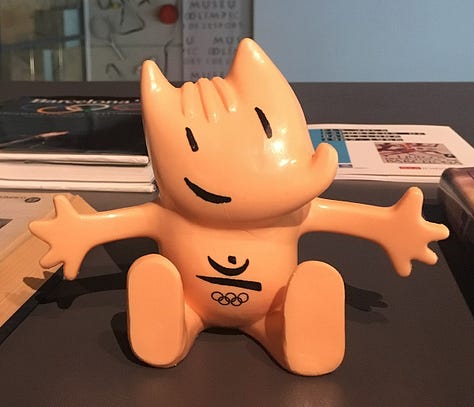
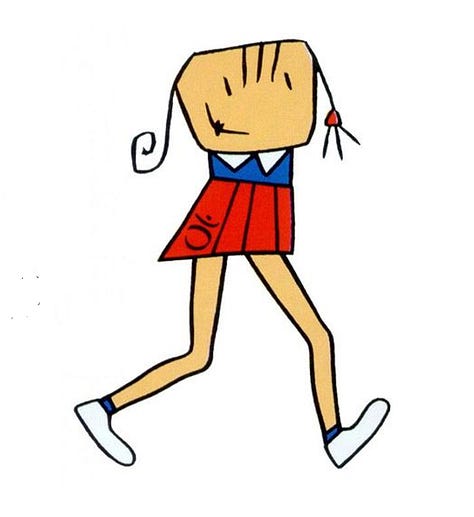
Here are some things I can tell you about Cobi:
He is a Catalan sheepdog, known locally as a gos d'atura. If you’re wondering what a Catalan Sheepdog looks like, the answer is “not particularly like Cobi.”1
His design is inspired by Cubism, apparently specifically Picasso’s interpretations of Velazquez’s painting Las Meninas.
His name comes from the Barcelona Olympic Organising Committee (COOB).
His designer, Javier Mariscal, had a few other mascot ideas kicking around, including a cheerful lobster, an anthropomorphized palm tree that seemed to involve some element of racial caricature,2 and an armless girl named Petra. Petra was inspired by Mariscal’s friend Lorenza Böttner, a transgender disabled artist who seems like she did really amazing work (including painting using her mouth and feet) before dying of complications from AIDS in 1994. Böttner portrayed Petra at live events during the Paralympics, which curator Paul B. Preciado years later characterized as a complex act of conceptual art:
“Lorenza’s functionally diverse body paradoxically disappeared under the character’s voluminous disguise. By hiding her body and face, the Petra mascot was, in itself, infantilising and desubjectivising. But Lorenza saw in Petra the possibility of subverting disabled identity through trans embodiment. The last public face of Lorenza, Petra was the symbol of triumph—in the 1990s—of postmodern diversity inclusion policies, of the charity telethon, and of the disability industries in which the functionally diverse body was included in society at the price of social submission: personal heroism, prosthetic readaptation, and athletic achievement kept the non-conforming body in a position of political subalternity.” And there you have it!
Lillehammer, Winter 1994: Håkon, Kristin, and Sondre
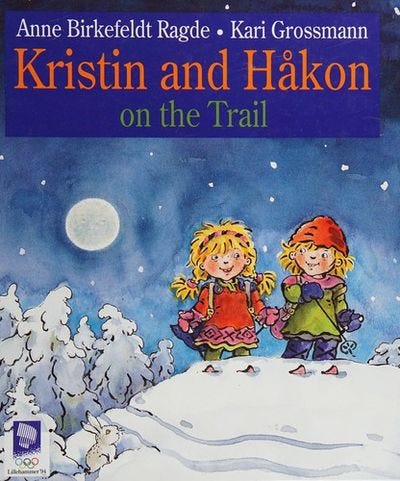

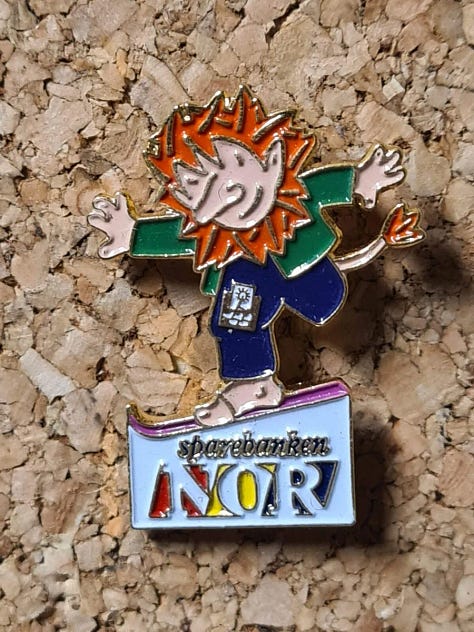
Kristin and Håkon are the first ever humans to serve as Olympic mascots. Their names come from Norwegian historical royals who were actually aunt and nephew! The Olympics website is careful to emphasize that “although they wear medieval clothes in reference to their historical roots, they are modern children and express the interests and visions of young people.”
The Olympics people recruited eight pairs of 10- and 11-year old children to portray K&H at the Games, with duties including “smiling and waving at people” and “reciting poems at medal ceremonies for some reason.” It sounds like it was a fun time for them! In a retrospective video from 2018, one of the Kristins described a shirtless, mulleted French figure skater kissing her on the cheek, an experience she characterized as “really fantastic” and “a really special moment.”
Meanwhile, the Paralympic Committee asked some artists to create a mascot for the Paralympics with Kristin and Håkon-ish vibes, so they ended up with Sondre, a monoskiing troll with an amputated leg.
Atlanta, Summer 1996: Izzy and Blaze

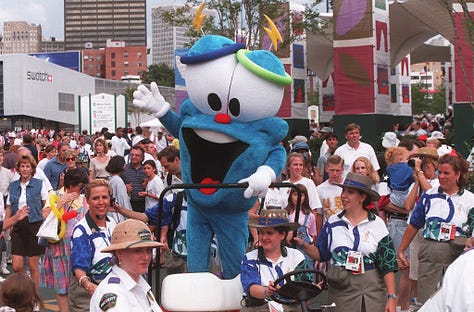

Apparently the Atlanta Olympics people contacted a bunch of design companies asking for mascot design ideas with the following specifications: “It needed to be unisex. It needed to be noncontroversial. It couldn’t relate to the Civil War or slavery.” The submissions they received included a cartoon version of Willie B., a beloved gorilla at Zoo Atlanta; a peanut named Peter Peach Nut; and a giant-eyed non-specific creature named Hi-Rez.
Somehow they picked the last one, which they renamed to Whatizit—because what…is it. Whatizit debuted and everyone hated it! Whatizit was an international punchline! People were already like “???” about Atlanta being an Olympic host city and Whatizit did NOT help!! The Olympics people were like “OK we need to fix this” and did a LOT of focus grouping, both for the name and the design. Apparently a very large amount of children wanted to name the mascot Kirby, but Kirby the Nintendo character was already a thing at this point, so they went with the second choice, Izzy. Design-wise, Izzy’s proportions were made vaguely less unsettling; the design team briefly considered making him wear his shoes backwards (because kids wore backwards baseball caps in the 90s) but somehow this was vetoed.
Izzy 2.0 was I guess better than the original design but he still was horrible to look at and completely baffling. Allegedly, people at the time would joke that the blue line indicating the marathon route start in Atlanta was “Izzy’s ass being dragged out of town,” although I have no idea if this is true or not.
Anyway, there was also a completely un-Izzy-like Paralympic mascot named Blaze, who probably would’ve made a much more reasonable mascot choice for the Olympics than Iz. Good for you, Blaze!
Nagano, Winter 1998: The Snowlets (Sukki, Nokki, Lekki, and Tsukki) and Parabbit
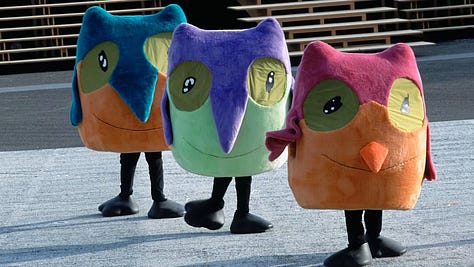


These guys! They are four snowy owls (there are four because there are four years in an Olympiad) representing fire, air, earth, and water. If you take the first syllable of each of their names you end up saying “Snowlets”! One thing about the Snowlets is that when you Google Image Search them—perhaps, say, to find Snowlet imagery to include in your unhinged Olympics newsletter—it’s very hard to tell what’s canon and what’s fanart because even the most official Snowlet branding looks like it was done in MS Paint. I love them.
The Paralympic mascot that year was the Parabbit, who seems to have very little lore—sorry, Parabbit!
Sydney, Summer 2000: Ollie, Syd, Millie, and Lizzie
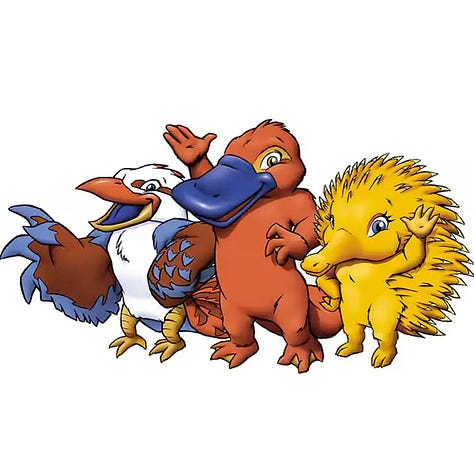
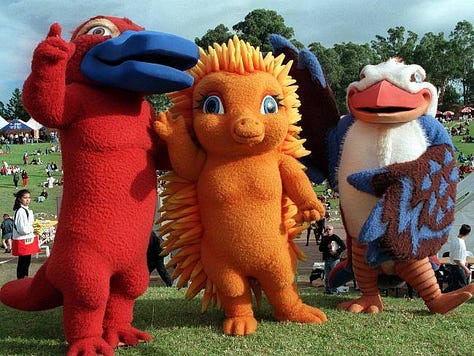
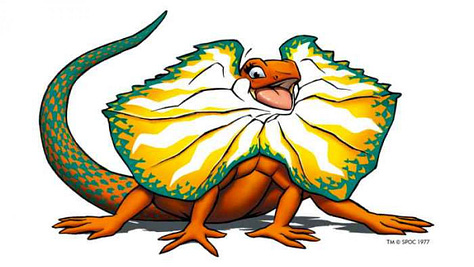
According to the Olympics website, the Australian Olympic Committee specifically wanted to avoid using kangaroos and koalas as mascots, so they went with the somewhat lower-profile kookaburra, platypus, and echidna. Their names were short for “Olympics,” “Sydney,” and “Millennium,” which sort of feels like what you would get if you asked ChatGPT to name three unspecified mascots for the 2000 Olympic Games in Sydney.
Compared to previous years, the 2000 Paralympic mascot was relatively cohesive with her Olympic counterparts, though not as integrated as we’ll start to see later in the new millennium. Lizzie was created by the same artists as OS&M, features a frill shaped like her home country’s outline, and was voiced by Olivia Newton-John in animated appearances.
BONUS: Fatso the Fat-Arsed Wombat, Sydney 2000’s Unauthorized Anti-Mascot
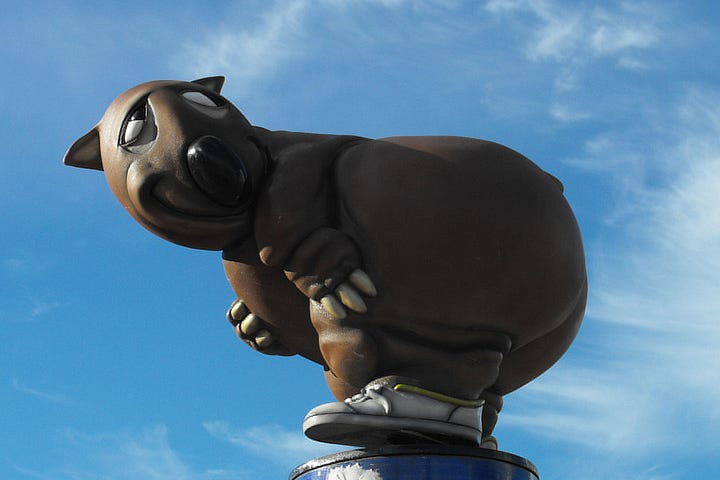
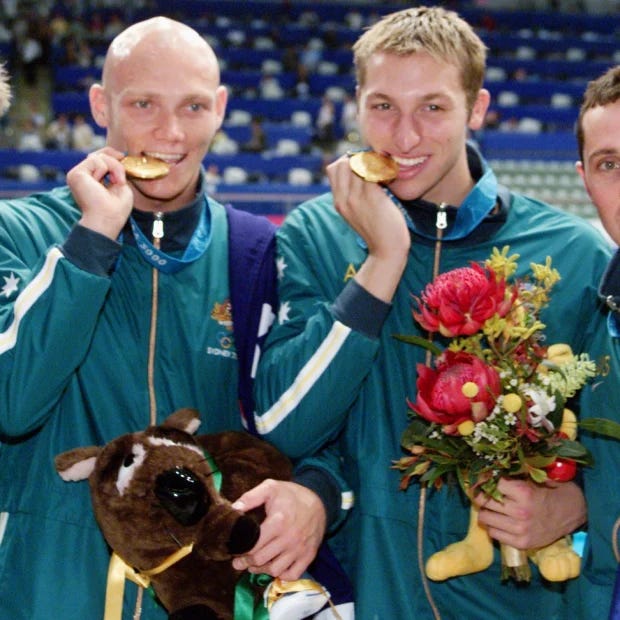
Australian late-night television comedians John Doyle and Greig Pickhaver were real Syd, Ollie, and Millie haters—which I genuinely can’t blame them for—and subsequently created their own rival mascot. “These mascots have given us the shits forever. None of them are any good. They're obviously constructed usually by some sort of marketing backroom...[but] we understood what Australia wants,” they told Sydney Morning Herald. “What we wanted to invent was a mascot that was not for sale, that somehow represented the higher Olympic ideals—or the ideals the Olympics once pretended to have. The only instruction was that he had to have a huge arse.”
They teamed up with local cartoonist Paul Newell to create Fatso, who he described as having “a bit of that ratbag larrikinism that's part of Australia.” Fatso was a fixture of Doyle and Pickhaver’s show during the Olympics. He became notorious when one of D&P’s producers handed a Fatso plushie to the Australian 4x200m freestyle relay team as they stepped up to the podium to get their gold medal; from a branding perspective, the resulting photo of Fatso on the podium was very distressing for Australian Olympic Committee.
Despite or perhaps because of his unsanctioned status, Fatso was beloved and popular where Syd, Ollie, and Millie were not. His creators described him as “the battlers’ prince,” which I believe is an Australian way to call him a “the people’s princess.” Fatso’s impact was commemorated with a statue outside Sydney’s ANZ Stadium, a monument that was stolen in 2010; problematically, local police allegedly neglected to thoroughly investigate the theft. While the mystery of the missing statue remains unsolved, the Sydney Olympic Park Authority finally put in a replacement sculpture 10 years later.
Apparently Catalan Sheepdogs are intelligent, cheerful, good at “doggy-dance,” and able to “guard sheep without needing instruction,” although Wikipedia provides no citation for this. Did a Catalan sheepdog write this????
This is where I’m getting that information from, so I’m not particularly confident in my interpretation of what was going on with Palmerito.





also Izzy is beautiful shame on you
here’s to hoping we can get a non-racist palm tree mascot someday soon.